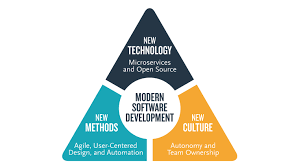Modern Software Engineering: Embracing Innovation and Efficiency
Published on October 10, 2023
Introduction
The field of software engineering has undergone a significant transformation over the past few decades. From the early days of coding in assembly language to the current era of agile methodologies and cloud computing, modern software engineering is characterized by its emphasis on innovation, efficiency, and collaboration.
Agile Methodologies
One of the most notable shifts in modern software engineering is the widespread adoption of agile methodologies. Agile practices prioritize iterative development, continuous feedback, and cross-functional teams. This approach allows for greater flexibility and responsiveness to changing requirements.
“Individuals and interactions over processes and tools; Working software over comprehensive documentation; Customer collaboration over contract negotiation; Responding to change over following a plan.”
The principles outlined in the Agile Manifesto have become foundational to many organizations seeking to improve their development processes.
DevOps Integration
DevOps is another crucial aspect of modern software engineering. By integrating development (Dev) and operations (Ops), DevOps aims to shorten the system development life cycle while delivering features, fixes, and updates frequently in close alignment with business objectives.
- Continuous Integration (CI): Developers frequently merge their code changes into a central repository where automated builds and tests are run.
- Continuous Delivery (CD): Ensures that code changes are automatically prepared for a release to production.
- Infrastructure as Code (IaC): Managing and provisioning computing infrastructure through machine-readable definition files.
The integration of DevOps practices enhances collaboration between teams, reduces deployment failures, and accelerates time-to-market.
Cloud Computing
The advent of cloud computing has revolutionized how software applications are developed, deployed, and managed. Cloud platforms like Amazon Web Services (AWS), Microsoft Azure, and Google Cloud provide scalable infrastructure that can be provisioned on-demand.
This shift enables developers to focus more on writing code rather than managing servers. Additionally, cloud-native architectures such as microservices allow for building resilient applications that can scale efficiently with user demand.
This shift enables developers to focus more on writing code rather than managing servers. Additionally, cloud-native architectures such as microservices allow for building resilient applications that can scale efficiently with user demand.
This shift enables developers to focus more on writing code rather than managing servers. Additionally, cloud-native architectures such as microservices allow for building resilient applications that can scale efficiently with user demand.
This shift enables developers to focus more on writing code rather than managing servers. Additionally, cloud-native architectures such as microservices allow for building resilient applications that can scale efficiently with user demand.
This shift enables developers to focus more on writing code rather than managing servers. Additionally, cloud-native architectures such as microservices allow for building resilient applications that can scale efficiently with user demand.
The Role of AI & Machine Learning
The Role of AI & Machine Learning
The Role of AI & Machine Learning
The Role of AI & Machine Learning

